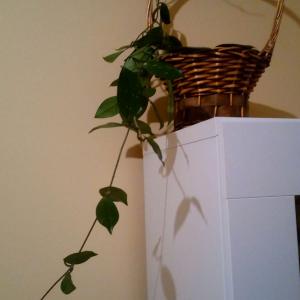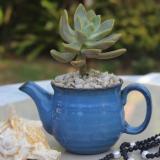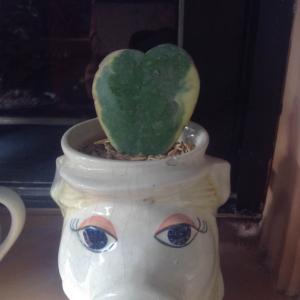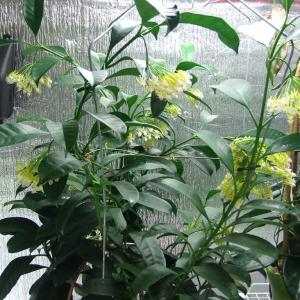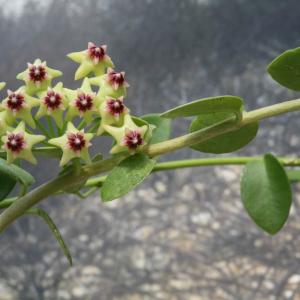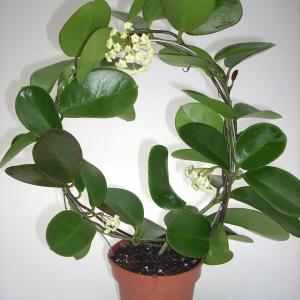文章
Dummer. ゛☀
2017年10月02日

Scientific Name
Hoya macgillivrayi F. M. Bailey

Synonyms
Hypericum assurgens, Hypericum deidesheimense, Hypericum lineolatum, Hypericum marylandicum
Scientific Classification
Family: Apocynaceae
Subfamily: Asclepiadoideae
Tribe: Marsdenieae
Genus: Hoya
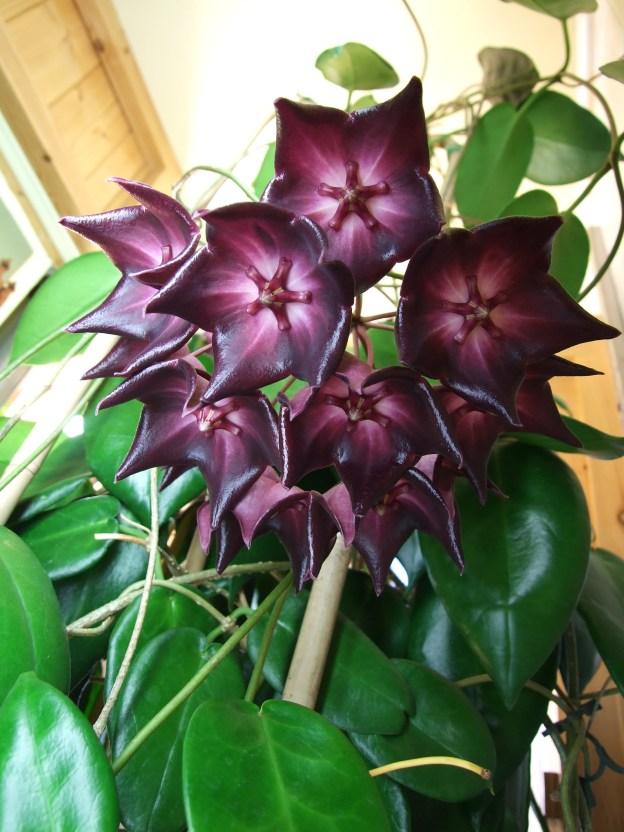
Flower
Color: Dark burgundy
Bloom Time: Mid spring to early summer
Description
Hoya macgillivrayi is a fast-growing root climber and twiner with thick, oval, pointed leaves which are light green and set opposite each other on the twining stems. The flowers are up to 2.4 inches (6 cm) wide on long stalks and are borne in umbels of 6 to 10 flowers that are each connected at a central axis. Each flower is a dark burgundy color with five sepals and five petals. The stamen are enclosed in the corona. The fruit produced are two pairs of follicles that are 10 inches (25 cm) long from which a flat seed is produced that is distributed by the wind.
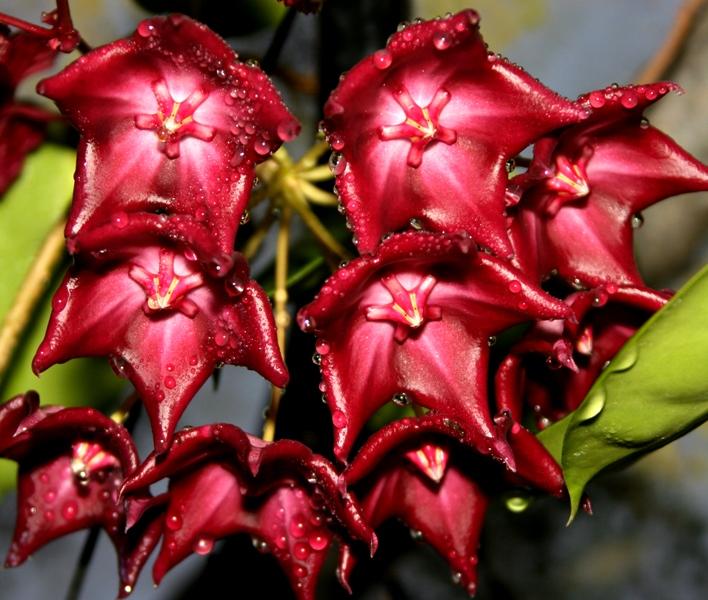
How to Grow and Care
Hoya plants don’t ask for much, beyond the well-draining soil and the warm humid conditions that many tropical flowers crave. They don’t like wet feet or heavy soil, and as many grow as epiphytes in nature (similar to bromeliads and orchids). Give them at least a half day of sunshine, and bring them indoors when temperatures drop below 50 degrees F (10 degrees C).
When your Hoyas finishes blooming, leave the flower stalk, as it may produce new flowers. Removing the stalk forces the plant to produce a new stalk, which delays blooming and wastes the plant’s energy. They are light feeders, and a monthly drink of compost tea or dilute fish emulsion provides all the nutrition these tropicals need. Hoyas like the security of a snug pot, and plants that are a bit root bound will flower more prolifically than those that are swimming around in a giant pot.
Origin
Native to northeastern Australia.
Hoya macgillivrayi F. M. Bailey

Synonyms
Hypericum assurgens, Hypericum deidesheimense, Hypericum lineolatum, Hypericum marylandicum
Scientific Classification
Family: Apocynaceae
Subfamily: Asclepiadoideae
Tribe: Marsdenieae
Genus: Hoya

Flower
Color: Dark burgundy
Bloom Time: Mid spring to early summer
Description
Hoya macgillivrayi is a fast-growing root climber and twiner with thick, oval, pointed leaves which are light green and set opposite each other on the twining stems. The flowers are up to 2.4 inches (6 cm) wide on long stalks and are borne in umbels of 6 to 10 flowers that are each connected at a central axis. Each flower is a dark burgundy color with five sepals and five petals. The stamen are enclosed in the corona. The fruit produced are two pairs of follicles that are 10 inches (25 cm) long from which a flat seed is produced that is distributed by the wind.

How to Grow and Care
Hoya plants don’t ask for much, beyond the well-draining soil and the warm humid conditions that many tropical flowers crave. They don’t like wet feet or heavy soil, and as many grow as epiphytes in nature (similar to bromeliads and orchids). Give them at least a half day of sunshine, and bring them indoors when temperatures drop below 50 degrees F (10 degrees C).
When your Hoyas finishes blooming, leave the flower stalk, as it may produce new flowers. Removing the stalk forces the plant to produce a new stalk, which delays blooming and wastes the plant’s energy. They are light feeders, and a monthly drink of compost tea or dilute fish emulsion provides all the nutrition these tropicals need. Hoyas like the security of a snug pot, and plants that are a bit root bound will flower more prolifically than those that are swimming around in a giant pot.
Origin
Native to northeastern Australia.
1
0
文章
Dummer. ゛☀
2017年10月02日

Scientific Name
Hoya carnosa (L.f.) R.Br.

Common Names
Wax Plant, Porcelain Flower
Synonyms
Asclepias carnosa, Cynanchum carnosum, Schollia carnosa
Scientific Classification
Family: Apocynaceae
Subfamily: Asclepiadoideae
Tribe: Marsdenieae
Genus: Hoya

Flower
Color: Typically light pink
Bloom Time: Mid spring to early summer
Description
Hoya carnosa is a vining succulent that roots along it long, branching stems. In the wild it climbs trees and scrambles over rocks, growing continuously and reaching lengths of 20 feet (6 m) or more. The leaves are smooth, thick and fleshy, up to 3 inches (7.5 cm) long, and paired on opposite sides along the stems. Twenty or more star shaped flowers up to 0.5 inch (1.5 cm) across, typically light pink (but may vary from near-white to dark pink), are borne in pendulous convex clusters, 2 or 3 inches (5 or 8 cm) across.

How to Grow and Care
Hoya plants don’t ask for much, beyond the well-draining soil and the warm humid conditions that many tropical flowers crave. They don’t like wet feet or heavy soil, and as many grow as epiphytes in nature (similar to bromeliads and orchids). Give them at least a half day of sunshine, and bring them indoors when temperatures drop below 50 degrees F (10 degrees C).
When your Hoyas finishes blooming, leave the flower stalk, as it may produce new flowers. Removing the stalk forces the plant to produce a new stalk, which delays blooming and wastes the plant’s energy. They are light feeders, and a monthly drink of compost tea or dilute fish emulsion provides all the nutrition these tropicals need. Hoyas like the security of a snug pot, and plants that are a bit root bound will flower more prolifically than those that are swimming around in a giant pot.
Origin
Native to Eastern Asia and Australia.
Hoya carnosa (L.f.) R.Br.

Common Names
Wax Plant, Porcelain Flower
Synonyms
Asclepias carnosa, Cynanchum carnosum, Schollia carnosa
Scientific Classification
Family: Apocynaceae
Subfamily: Asclepiadoideae
Tribe: Marsdenieae
Genus: Hoya

Flower
Color: Typically light pink
Bloom Time: Mid spring to early summer
Description
Hoya carnosa is a vining succulent that roots along it long, branching stems. In the wild it climbs trees and scrambles over rocks, growing continuously and reaching lengths of 20 feet (6 m) or more. The leaves are smooth, thick and fleshy, up to 3 inches (7.5 cm) long, and paired on opposite sides along the stems. Twenty or more star shaped flowers up to 0.5 inch (1.5 cm) across, typically light pink (but may vary from near-white to dark pink), are borne in pendulous convex clusters, 2 or 3 inches (5 or 8 cm) across.

How to Grow and Care
Hoya plants don’t ask for much, beyond the well-draining soil and the warm humid conditions that many tropical flowers crave. They don’t like wet feet or heavy soil, and as many grow as epiphytes in nature (similar to bromeliads and orchids). Give them at least a half day of sunshine, and bring them indoors when temperatures drop below 50 degrees F (10 degrees C).
When your Hoyas finishes blooming, leave the flower stalk, as it may produce new flowers. Removing the stalk forces the plant to produce a new stalk, which delays blooming and wastes the plant’s energy. They are light feeders, and a monthly drink of compost tea or dilute fish emulsion provides all the nutrition these tropicals need. Hoyas like the security of a snug pot, and plants that are a bit root bound will flower more prolifically than those that are swimming around in a giant pot.
Origin
Native to Eastern Asia and Australia.
1
3
Yve:Monkey fiddle
文章
Dummer. ゛☀
2017年10月01日

Scientific Name
Hoya compacta C.M. Burton
Common Names
Hindu Rope Plant, Hindu Rope, Hindu Rope Hoya, Indian Rope, Angel Rope, Wax Plant, Porcelain Flower, Krinkle Kurl
Synonyms
Hoya carnosa f. compacta, Hoya carnosa ‘Compacta’, Hoya compacta ‘Krinkle Kurl’
Scientific Classification
Family: Apocynaceae
Subfamily: Asclepiadoideae
Tribe: Marsdenieae
Genus: Hoya
Description
Hoya compacta is draping succulent vine that produce clusters of star-shaped waxy flowers. The curly leaves grow close on the vine making it possible to miss new peduncles and buds until they are quite big. The leaves vary in size and color, but they can be described as curly H. carnosa leaves. The flowers are mostly pale pink and the white corona has a red ring in the middle. The flowers form almost round balls and you can find 30-50 flowers in an umbel. Each flower is up to 0.6 inch (1.5 cm) across. The flowers last about one week.
How to Grow and Care
Hoya plants don’t ask for much, beyond the well-draining soil and the warm humid conditions that many tropical flowers crave. They don’t like wet feet or heavy soil, and as many grow as epiphytes in nature (similar to bromeliads and orchids). Give them at least a half day of sunshine, and bring them indoors when temperatures drop below 50 degrees F (10 degrees C).
When your Hoyas finishes blooming, leave the flower stalk, as it may produce new flowers. Removing the stalk forces the plant to produce a new stalk, which delays blooming and wastes the plant’s energy. They are light feeders, and a monthly drink of compost tea or dilute fish emulsion provides all the nutrition these tropicals need.
Hoya compacta C.M. Burton

Common Names
Hindu Rope Plant, Hindu Rope, Hindu Rope Hoya, Indian Rope, Angel Rope, Wax Plant, Porcelain Flower, Krinkle Kurl
Synonyms
Hoya carnosa f. compacta, Hoya carnosa ‘Compacta’, Hoya compacta ‘Krinkle Kurl’
Scientific Classification
Family: Apocynaceae
Subfamily: Asclepiadoideae
Tribe: Marsdenieae

Genus: Hoya
Description
Hoya compacta is draping succulent vine that produce clusters of star-shaped waxy flowers. The curly leaves grow close on the vine making it possible to miss new peduncles and buds until they are quite big. The leaves vary in size and color, but they can be described as curly H. carnosa leaves. The flowers are mostly pale pink and the white corona has a red ring in the middle. The flowers form almost round balls and you can find 30-50 flowers in an umbel. Each flower is up to 0.6 inch (1.5 cm) across. The flowers last about one week.

How to Grow and Care
Hoya plants don’t ask for much, beyond the well-draining soil and the warm humid conditions that many tropical flowers crave. They don’t like wet feet or heavy soil, and as many grow as epiphytes in nature (similar to bromeliads and orchids). Give them at least a half day of sunshine, and bring them indoors when temperatures drop below 50 degrees F (10 degrees C).

When your Hoyas finishes blooming, leave the flower stalk, as it may produce new flowers. Removing the stalk forces the plant to produce a new stalk, which delays blooming and wastes the plant’s energy. They are light feeders, and a monthly drink of compost tea or dilute fish emulsion provides all the nutrition these tropicals need.
1
0
文章
Dummer. ゛☀
2017年09月20日

The Hoya plant is known for its thick leaves and a characteristic shape. They are climbing and clambering so they make a very interesting sight in any home. Hoyas are also known as The Hindu Rope or Wax Plant. They are wax-stemmed and produce beautiful flowers. Many people like to grow them in their home, balcony or garden.
These plants have been enjoyed for decades and they are very popular among many home gardeners. Hoyas plant has wheel-like clusters of porcelain or waxy flowers. The flowers typically have stars in their crowns. The flowers often produce unique, enjoyable fragrance.
This plant was named in honor of Thomas Hoym, who was a gardener for the Duke of Northumberland. Hoym was the first one who recognized the beauty and uniqueness of this plant and he brought it into prominence.
Hoyas are native to southern India. There, the Hoya plant is highly prized and it’s even a subject of legend. These plants are also commonly found throughout eastern Asia and Australia. There are many species, but it’s not clear how many of them are there exactly. According to the Bailey’s Standard Cyclopedia of Horticulture, there are around 100 species of these plant.
Growing Conditions
Light: A north window is a good location. Although the plants do not require direct light, they would not do well away from a window, unless you prefer to grow them under fluorescent grow lights. Supply all but the hottest sun.
Water: Keep the soil moist in spring and summer, dry but not to the point of shriveled foliage in winter. In dry climates more frequent watering may be necessary. Some like to mist the leaves frequently, to clean them and increase humidity…but NOT when the plant is budding or in flower.
Temperature: Give them medium (50 degrees F/10 degrees C) to warm temperatures during the growing season—spring and summer. The plants go semi-dormant in winter.
Soil: A moist, well-drained, light soil – African Violet soil with some added perlite – is a good growing medium.
Fertilizer: In spring Hoyas react favorably to feeding. A liquid food, about every four weeks, three or four times during the growing season will produce a vigorous growth. Withhold food during the winter.
Propagation
Propagate Hoyas by cuttings of top growth, or by leaf cuttings in the same manner as African Violets and Gloxinias. The average cutting or leaf start will produce a blooming plant in two years or less. The easiest method of propagation is by layering. Layers mature faster and do not need as much patience. Pin down a stem, at the joint, in a moist rooting medium. Sever and pot the new plant when roots have formed.
Grower’s Tips
Hoya plants don’t ask for much, beyond the well-draining soil and the warm humid conditions that many tropical flowers crave. They don’t like wet feet or heavy soil, and as many grow as epiphytes in nature (similar to bromeliads and orchids). Give them at least a half day of sunshine, and bring them indoors when temperatures drop below 50 degrees F (10 degrees C).
When your Hoyas finishes blooming, leave the flower stalk, as it may produce new flowers. Removing the stalk forces the plant to produce a new stalk, which delays blooming and wastes the plant’s energy. They are light feeders, and a monthly drink of compost tea or dilute fish emulsion provides all the nutrition these tropicals need. Hoyas like the security of a snug pot, and plants that are a bit root bound will flower more prolifically than those that are swimming around in a giant pot.
Design Tips
Place your Hoya plant in a hanging basket where you can admire it from your favorite seat on the deck or porch. Hoyas will cling to a small trellis, providing a vertical accent in your tropical container garden. A Hoya plant would appreciate the humid conditions alongside any pond, fountain, or other water feature in your landscape.

These plants have been enjoyed for decades and they are very popular among many home gardeners. Hoyas plant has wheel-like clusters of porcelain or waxy flowers. The flowers typically have stars in their crowns. The flowers often produce unique, enjoyable fragrance.
This plant was named in honor of Thomas Hoym, who was a gardener for the Duke of Northumberland. Hoym was the first one who recognized the beauty and uniqueness of this plant and he brought it into prominence.

Hoyas are native to southern India. There, the Hoya plant is highly prized and it’s even a subject of legend. These plants are also commonly found throughout eastern Asia and Australia. There are many species, but it’s not clear how many of them are there exactly. According to the Bailey’s Standard Cyclopedia of Horticulture, there are around 100 species of these plant.

Growing Conditions
Light: A north window is a good location. Although the plants do not require direct light, they would not do well away from a window, unless you prefer to grow them under fluorescent grow lights. Supply all but the hottest sun.
Water: Keep the soil moist in spring and summer, dry but not to the point of shriveled foliage in winter. In dry climates more frequent watering may be necessary. Some like to mist the leaves frequently, to clean them and increase humidity…but NOT when the plant is budding or in flower.
Temperature: Give them medium (50 degrees F/10 degrees C) to warm temperatures during the growing season—spring and summer. The plants go semi-dormant in winter.

Soil: A moist, well-drained, light soil – African Violet soil with some added perlite – is a good growing medium.
Fertilizer: In spring Hoyas react favorably to feeding. A liquid food, about every four weeks, three or four times during the growing season will produce a vigorous growth. Withhold food during the winter.
Propagation
Propagate Hoyas by cuttings of top growth, or by leaf cuttings in the same manner as African Violets and Gloxinias. The average cutting or leaf start will produce a blooming plant in two years or less. The easiest method of propagation is by layering. Layers mature faster and do not need as much patience. Pin down a stem, at the joint, in a moist rooting medium. Sever and pot the new plant when roots have formed.

Grower’s Tips
Hoya plants don’t ask for much, beyond the well-draining soil and the warm humid conditions that many tropical flowers crave. They don’t like wet feet or heavy soil, and as many grow as epiphytes in nature (similar to bromeliads and orchids). Give them at least a half day of sunshine, and bring them indoors when temperatures drop below 50 degrees F (10 degrees C).
When your Hoyas finishes blooming, leave the flower stalk, as it may produce new flowers. Removing the stalk forces the plant to produce a new stalk, which delays blooming and wastes the plant’s energy. They are light feeders, and a monthly drink of compost tea or dilute fish emulsion provides all the nutrition these tropicals need. Hoyas like the security of a snug pot, and plants that are a bit root bound will flower more prolifically than those that are swimming around in a giant pot.

Design Tips
Place your Hoya plant in a hanging basket where you can admire it from your favorite seat on the deck or porch. Hoyas will cling to a small trellis, providing a vertical accent in your tropical container garden. A Hoya plant would appreciate the humid conditions alongside any pond, fountain, or other water feature in your landscape.
2
1
文章
Dummer. ゛☀
2017年08月21日

Sweetheart hoya plant, also known as Valentine plant or sweetheart wax plant, is a type of Hoya appropriately named for its thick, succulent, heart-shaped leaves. Like other Hoya varieties, sweetheart hoya plant is a stunning, low-maintenance indoor plant. Read on for additional wax plant info.
Hoya Wax Plant Info
Native to Southeast Asia, sweetheart hoya (Hoya kerrii) is often a quirky Valentine’s Day gift with a single 5-inch leaf planted upright in a small pot. Although the plant is relatively slow-growing, it appreciates a hanging basket, where it eventually becomes a bushy mass of green hearts. Mature plants can reach lengths of up to 13 feet. During the summer, clusters of white, burgundy-centered blooms provide bold contrast to the deep green or variegated leaves. One mature plant can display up to 25 blooms.
How to Grow a Sweetheart Wax Plant
Sweetheart hoya care isn’t complicated or involved, but the plant is somewhat particular about its growing conditions. This Valentine hoya tolerates relatively low light, but not full shade. However, the plant performs best and is more likely to bloom in bright or indirect sunlight. Room temperatures should be maintained between 60 and 80 F. or 15 and 26 C. With its fleshy, succulent leaves, sweetheart hoya is relatively drought-tolerant and can get by with as little as one or two waterings per month. Water deeply when the soil is slightly dry to the touch, then let the pot drain thoroughly.
Although the soil should never become bone dry, wet, soggy soil can result in deadly rot. Be sure sweetheart hoya is planted in a pot with a drainage hole. Sweetheart hoya is a light feeder and requires little fertilizer. A light solution of balanced, water-soluble houseplant fertilizer mixed at a rate of ¼ teaspoon in a gallon of water is plenty. Feed the plant once a month during the growing season and discontinue feeding in winter. If a mature plant doesn’t bloom, try exposing the plant to brighter light or cooler nighttime temperatures.

Hoya Wax Plant Info
Native to Southeast Asia, sweetheart hoya (Hoya kerrii) is often a quirky Valentine’s Day gift with a single 5-inch leaf planted upright in a small pot. Although the plant is relatively slow-growing, it appreciates a hanging basket, where it eventually becomes a bushy mass of green hearts. Mature plants can reach lengths of up to 13 feet. During the summer, clusters of white, burgundy-centered blooms provide bold contrast to the deep green or variegated leaves. One mature plant can display up to 25 blooms.

How to Grow a Sweetheart Wax Plant
Sweetheart hoya care isn’t complicated or involved, but the plant is somewhat particular about its growing conditions. This Valentine hoya tolerates relatively low light, but not full shade. However, the plant performs best and is more likely to bloom in bright or indirect sunlight. Room temperatures should be maintained between 60 and 80 F. or 15 and 26 C. With its fleshy, succulent leaves, sweetheart hoya is relatively drought-tolerant and can get by with as little as one or two waterings per month. Water deeply when the soil is slightly dry to the touch, then let the pot drain thoroughly.

Although the soil should never become bone dry, wet, soggy soil can result in deadly rot. Be sure sweetheart hoya is planted in a pot with a drainage hole. Sweetheart hoya is a light feeder and requires little fertilizer. A light solution of balanced, water-soluble houseplant fertilizer mixed at a rate of ¼ teaspoon in a gallon of water is plenty. Feed the plant once a month during the growing season and discontinue feeding in winter. If a mature plant doesn’t bloom, try exposing the plant to brighter light or cooler nighttime temperatures.
1
0
成长记
Plants Encyclopdias
2016年08月17日

Name: Wax Hearts
Latin: Hoya kerrii
Origin: Asia
Plant height: 20 - 200 cm
Reproduction: #Stems
Difficulty level: #Easy
Tags: #Asia #Hoyakerrii
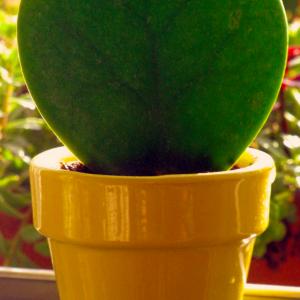
Latin: Hoya kerrii
Origin: Asia
Plant height: 20 - 200 cm
Reproduction: #Stems
Difficulty level: #Easy
Tags: #Asia #Hoyakerrii

5
3
成长记
Plants Encyclopdias
2016年08月17日

Name: Wax Plant
Latin: Hoya multiflora
Origin: Asia
Plant height: 50 - 300 cm
Reproduction: #Stems
Difficulty level: #Easy
Tags: #Asia #Hoyamultiflora

Latin: Hoya multiflora
Origin: Asia
Plant height: 50 - 300 cm
Reproduction: #Stems
Difficulty level: #Easy
Tags: #Asia #Hoyamultiflora

3
0





